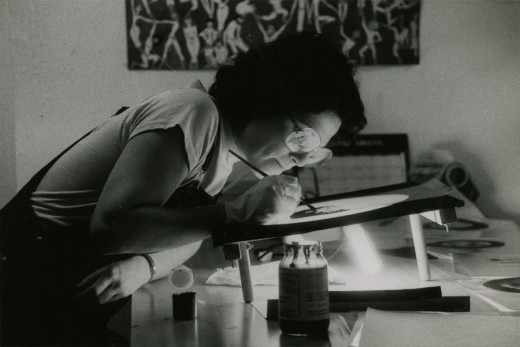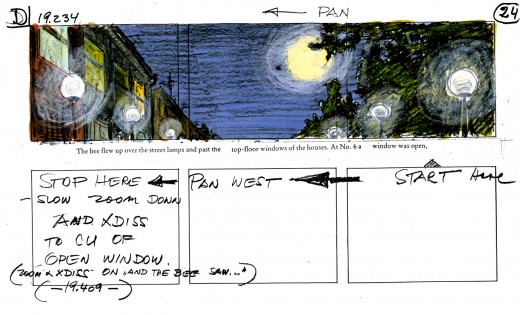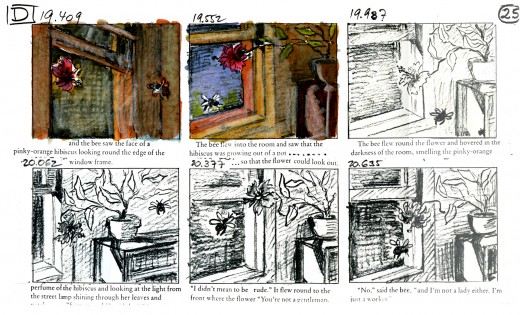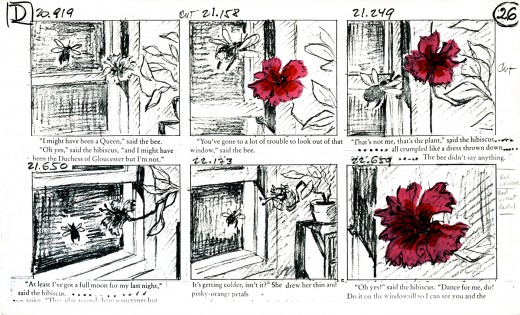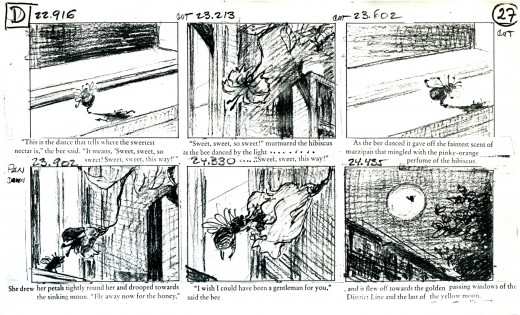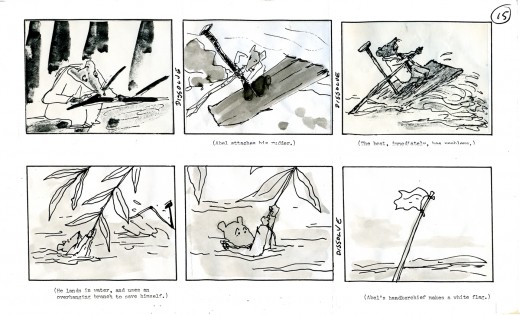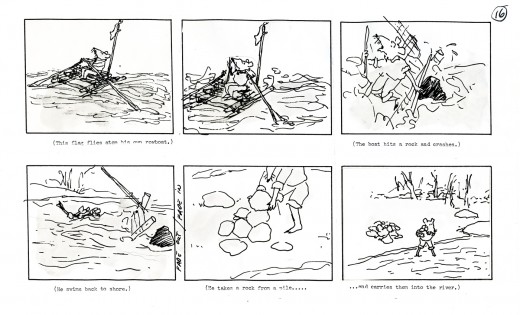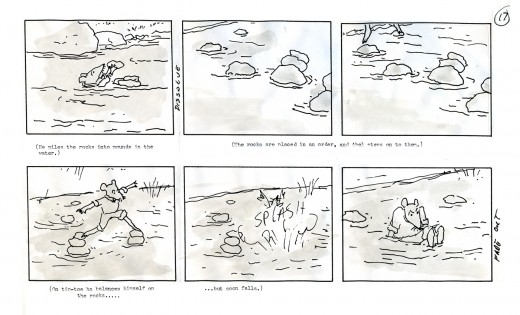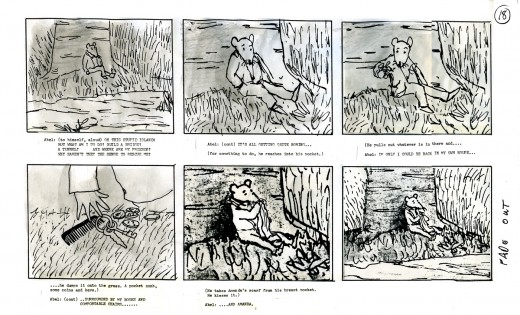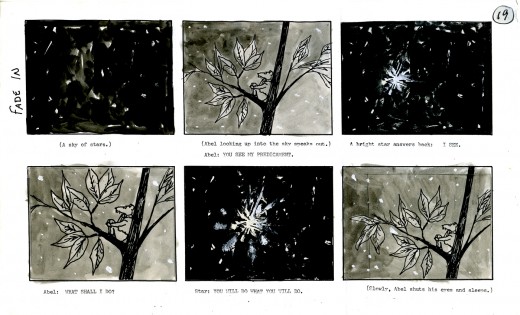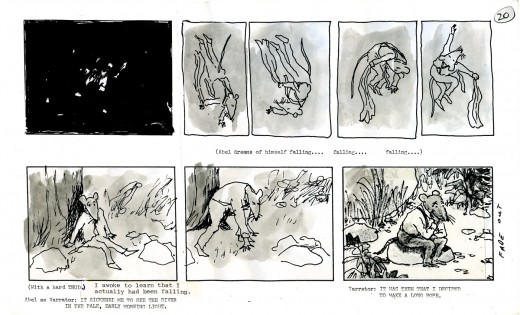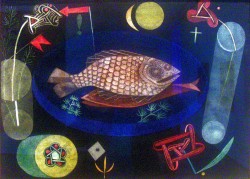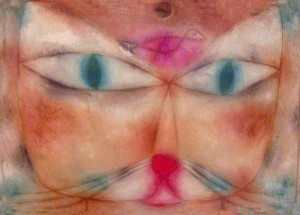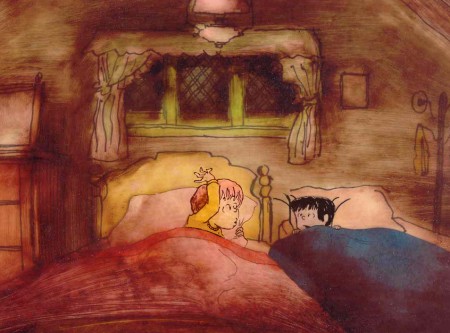Category ArchiveSpornFilms
Animation Artifacts &Photos &SpornFilms &Theater 01 Jun 2008 08:59 am
PhotoSunday Recap – WOTY
- Back in Jan 2007, I posted these photos from the animation production of Woman of the Year. I think these are interesting enough that they’re worth revisiting. So here, again, is that post:
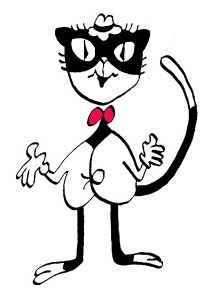 – To recap:
– To recap:
Woman of the Year was a project that came to me in the very start of my studio’s life – 1981.
Tony Walton, the enormously talented and fine designer, had gone to Richard Williams in search of a potential animator for WOTY (as we got to call the name of the show.) Dick recommended me. But before doing WOTY, there were some title segments needed for Prince of the City, a Sidney Lumet film. (I’ll discuss that film work some other day.)
Tony Walton designed the character, Katz, which would be the alter-ego of the show’s cartoonist hero, played by Harry Guardino. Through Katz, we’d learn about the problems of a relationship with a media star, played by Lauren Bacall.
It turned out to be a very intense production. Three minutes of animation turned into twelve as each segment was more successful than the last. ___________(All images enlarge by clicking.)
There was no time for pencil tests. I had to run
to Boston weekly, where the show was in try-outs, to project different segments; 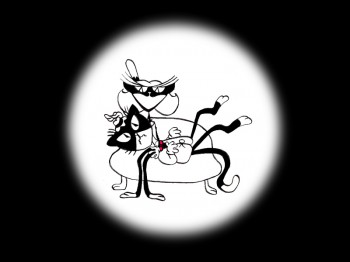 these went into the show that night – usually Wednesdays. I’d rush to the lab to get the dailies, speed to the editor, Sy Fried, to synch them up to a click track that was pre-recorded, then race to the airport to fly to the show for my first screening. Any animation blips would have to be corrected on Thursdays.
these went into the show that night – usually Wednesdays. I’d rush to the lab to get the dailies, speed to the editor, Sy Fried, to synch them up to a click track that was pre-recorded, then race to the airport to fly to the show for my first screening. Any animation blips would have to be corrected on Thursdays.
There was a small crew working out of a tiny east 32nd Street apartment. This was Dick Williams’ apartment in NY. He was rarely here, and when he did stay in NY, he didn’t stay at the apartment. He asked me to use it as my studio and to make sure the rent was paid on time and the mail was collected. Since we had to work crazy hours, it was a surprise one Saturday morning to find that I’d awakened elderly Jazz great, Max Kaminsky, who Dick had also loaned the apartment. Embarrassed, I ultimately moved to a larger studio – my own – shortly thereafter.
Here are a couple of photos of some of us working:
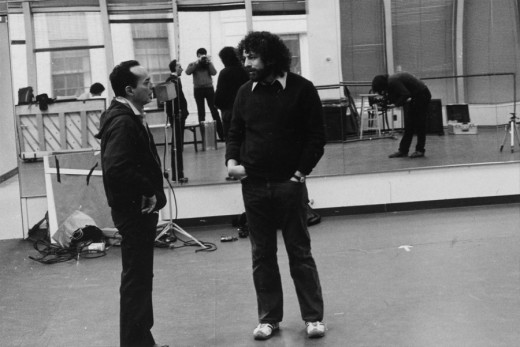
Tony Charmoli was the show’s choreographer. He worked with me in plotting out the big dance number – a duet between Harry Guardino and our cartoon character. I think this is the only time on Broadway that a cartoon character spoke and sang with a live actor on stage. John Canemaker is taking this photograph and Phillip Schopper is setting up the 16mm camera.

Here Tony Charmoli shows us how to do a dance step. Phillip Schopper, who is filming Tony, figures out how to set up his camera. We used Tony’s dancing as reference, but our animation moves were too broad for anyone to have thought they might have been rotoscoped.
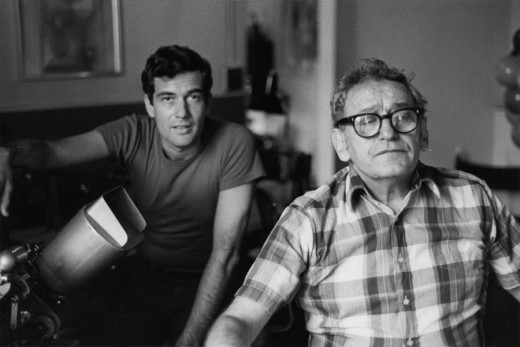
John Canemaker is working with Sy Fried, our editor. John did principal animation with me on the big number. Here they’re working with the click track and the live footage of Tony Charmoli to plot out the moves.
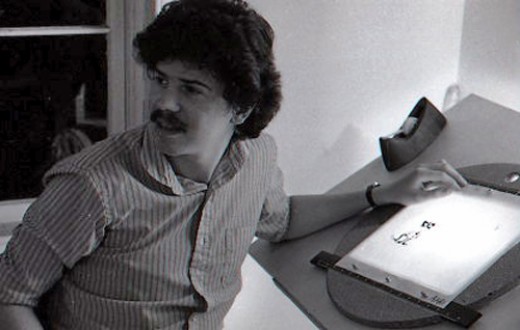
Steve Parton supervised the ink and paint. To get the sharpest lines, we inked on cels and didn’t color the drawings. It was B&W with a bright red bowtie. A spotlight matte over the character, bottom-lit on camera by Gary Becker.
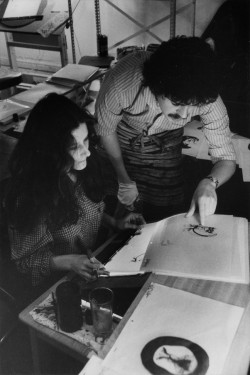 5
5  6
6
5. Steve Parton works with painter Barbara Samuels
6. Joey Epstein paints with fire in her eyes.
 8
8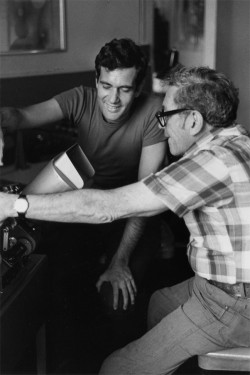 9
9
8. Harry Guardino on stage with the creation of “Tessie Kat” developing on screen behind him. This was Harry’s first big solo.
9. John Canemaker gets to see some of his animation with Sy Fried, editor.
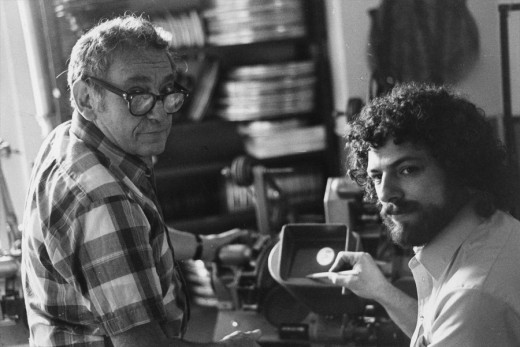
One of my quick stops from the lab on the way to Boston? No, I think this is a posed photo.
The success of the animation (including good reviews) posed a small problem for me. The rest of the show was ripped over the coals. When I started using some quotes about me in industrial ads, the producers came down on me for gloating over the others who’d gotten negative reviews.
All the same, it was a real learning experience in a big Broadway kinda way.
Animation &SpornFilms &Story & Storyboards &Tissa David 26 Apr 2008 09:37 am
Marzipan Pig Extra
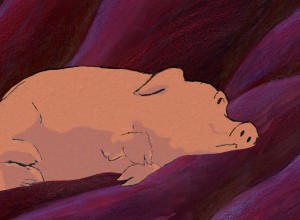 - As I stated recently, we’re currently preparing for the release of four more of our films on DVD this coming June. Each of two disks will hold two films. Included among the extras will be lots of stills including sequences worth of the storyboards.
- As I stated recently, we’re currently preparing for the release of four more of our films on DVD this coming June. Each of two disks will hold two films. Included among the extras will be lots of stills including sequences worth of the storyboards.
For The Marzipan Pig we’ve including a copy of a section of the animatic. This we’ll offer with the actual film superimposed over the stills so you can make a comparison as the film runs. I like this format; you can really take in the animation and layout of the piece when both are on the split screen.
I thought I’d post here some of the storyboards and the animatic for that section. Of course, this is in a low res version; more can be discovered in the dvd version.
Tissa David did the storyboard and animated the entire film by herself. This film is a beauty, if I do say so myself. It’s a truly adult film, though it was sold as a family film. It deals with love in all its forms, albeit, obviously, through metaphor. It was adapted from a brilliant children’s book by Russell Hoban, one of my favorite authors.
Quentin Blake illustrated the original book, and we didn’t purchase the illustrations. Hoban told us that it wasn’t how he’d imagined the pig to look, so he drew it for us. He was once an art director in an ad agency, so he can draw. This is the pig we used.
Hoban had hated what was done with his book, The Mouse and His Child, so demanded that all the spoken dialogue in the film be found among his words. We wrote a script; Maxine Fisher went to London to work with him in revising it. Finally, when it came to recording Tim Curry, I threw out the script and had him read the book. It was a good decision, and it made for a great performance from a great actor.
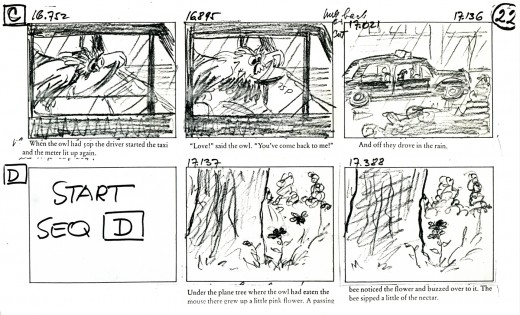
_____________(Click any image to enlarge.)
You’ll notice that some changes were made
in scenes and scene cuts as the animation progressed.
This is typical.
SpornFilms &Story & Storyboards 06 Apr 2008 09:29 am
Abel Extra
 I’m currently preparing two dvd’s for release this coming June. They’re some of my favorite titles. One will feature The Marzipan Pig and Jazztime Tale. The second will feature Abel’s Island and The Story of the Dancing Frog.
I’m currently preparing two dvd’s for release this coming June. They’re some of my favorite titles. One will feature The Marzipan Pig and Jazztime Tale. The second will feature Abel’s Island and The Story of the Dancing Frog.
Among these extras will be animatics for both dvds as well as storyboards to view. I’m currently working on Abel’s Island, and since I’ve been scanning that storyboard, I thought it worthwhile to post a bit of it.
The story:
Abel, a mouse, has just been washed onto an island far from his new wife. A gentleman, he doesn’t know how to survive, and he just wants to escape across the river to get home. This is where we pick him up as he slowly, very slowly learns to come to grips with living alone on an island.
The board was done by Bridget Thorne and me. We seem to have done about every other drawing together. I don’t remember working on it at all. It was done in 1987.

_________(Click any image to enlarge.
repeated posts &SpornFilms 04 Apr 2008 07:55 am
Recap Friday – Bridget Thorne
- The key to my studio in the first dozen or so years was the brilliant artist, Bridget Thorne. She was every bit my partner in creating some of the greatest of my films, and I can’t attribute more to her work. With this post, back in March 2006, I gave some small attention to some of the excellent art she’d done for my films. Time to show it off again.
Bridget Thorne has been an extraordinary Art Director and Background painter on quite a few of my favorite films produced within the studio. Here is some of that art.
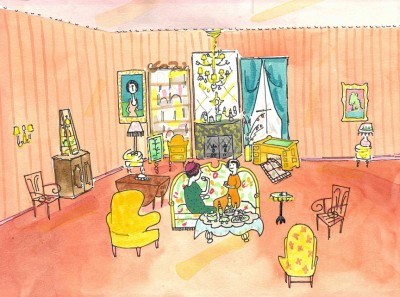 This painting is a key transition point in Lyle, Lyle Crocodile. The film had a looseness that Bernard Waber‘s original book art had featured. I felt very much at home in Waber’s style, and I think Bridget did as well.
This painting is a key transition point in Lyle, Lyle Crocodile. The film had a looseness that Bernard Waber‘s original book art had featured. I felt very much at home in Waber’s style, and I think Bridget did as well.
She worked out a color scheme for the film, and we both agreed to
______ (Click image to enlarge) Lyle, Lyle Crocodile (1987) _____.__follow it closely
___________________________________________________________throughout the half hour film for HBO. Liz Seidman lead the character coloring. Bridget, of course, had a strong hand in all those character models, as well.
The scene pictured above follows the introduction of Autumn on “East 88th Street”, and the background brings us full force into it as we get “the girl’s first song” – Mrs. Primm’s report on what it’s like to have a crocodile living in your house.
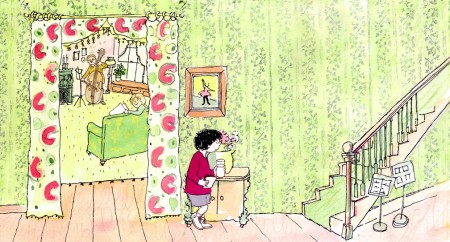 – Ira Sleeps Over was the second children’s book by Bernard Waber that we adapted. This is a very sweet story which involves a sibling rivalry; it focusses on a teddy bear and a sleep-over party. I pulled composer, William Finn, into the film and he wrote some great tunes for it. Prior to doing the script, I gave him the book and asked him to figure out where he would like the songs. In a week he had already written all the songs for the film, and they were brilliant. It turned out he used all the words of the book in his songs, and now I had to find a way of telling the same story using past, present and future tenses, as he did in the songs. It was a good challenge that worked out well and created a fabulous construction for the story.
– Ira Sleeps Over was the second children’s book by Bernard Waber that we adapted. This is a very sweet story which involves a sibling rivalry; it focusses on a teddy bear and a sleep-over party. I pulled composer, William Finn, into the film and he wrote some great tunes for it. Prior to doing the script, I gave him the book and asked him to figure out where he would like the songs. In a week he had already written all the songs for the film, and they were brilliant. It turned out he used all the words of the book in his songs, and now I had to find a way of telling the same story using past, present and future tenses, as he did in the songs. It was a good challenge that worked out well and created a fabulous construction for the story.
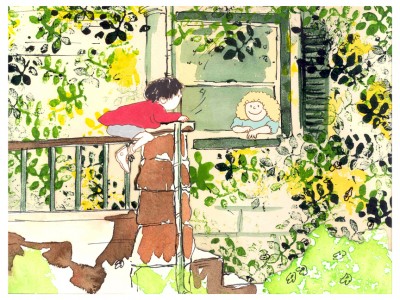 The style in this book was, if anything, looser than in Lyle. Waber did a lot of his illustration featuring duplicating printing techniques. Lino cut enabled him to repeat decorations throughout the settings. Bridget played with the lino cuts and was able to succesffully duplicate the technique in the backgrounds. In this one bg, at the beginning of the film, the foliage is a good example of this technique, printed over watercolors. The characters are markered paper drawings cut out and pasted to the cel overlays.
The style in this book was, if anything, looser than in Lyle. Waber did a lot of his illustration featuring duplicating printing techniques. Lino cut enabled him to repeat decorations throughout the settings. Bridget played with the lino cuts and was able to succesffully duplicate the technique in the backgrounds. In this one bg, at the beginning of the film, the foliage is a good example of this technique, printed over watercolors. The characters are markered paper drawings cut out and pasted to the cel overlays.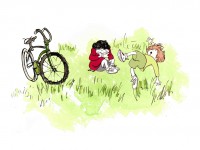
The book, like Lyle, featured a lot of white space, so we followed suit. When a book’s been in circulation for over 25 years, you have to realize there’s been a reason for it; find the reason and the heart, and take advantage of it. This use of white space made the actual backgrounds oftentimes little more than abstract shapes of color with a solid object on the screen. Here, for example, we see Ira and his friend, Reggie, playing against a blast of green and a bicycle.
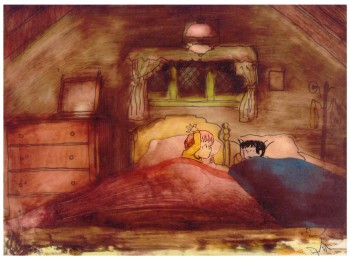 – At the end of the film, Ira and Reggie talk in the dark at the sleep-over. To get the look of the dark Bridget had to come up with something clever. The book resorted to B&W washes of gray and wasn’t very helpful. She came up with some dyes that were used for photo retouching. By quickly painting these lightly onto cel levels with a wide brush, she was able to get translucent cels with the brush strokes imbedded in the color overlays. By placing these overlays over the characters and backgrounds, we got the desired effect that let it feel connected to the very loose style of the film.
– At the end of the film, Ira and Reggie talk in the dark at the sleep-over. To get the look of the dark Bridget had to come up with something clever. The book resorted to B&W washes of gray and wasn’t very helpful. She came up with some dyes that were used for photo retouching. By quickly painting these lightly onto cel levels with a wide brush, she was able to get translucent cels with the brush strokes imbedded in the color overlays. By placing these overlays over the characters and backgrounds, we got the desired effect that let it feel connected to the very loose style of the film.
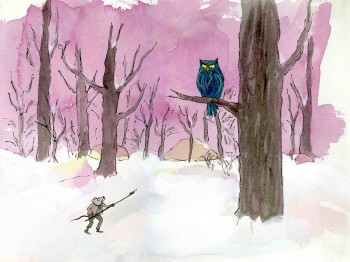 -Abel’s Island is one of the few films we did that I treasure for its artwork. Bridget’s work on the backgrounds was, to me, extraordinary. The looseness I love was developed into enormously lush backgrounds using shades of green that I didn’t know could be captured in the delicate watercolors.
-Abel’s Island is one of the few films we did that I treasure for its artwork. Bridget’s work on the backgrounds was, to me, extraordinary. The looseness I love was developed into enormously lush backgrounds using shades of green that I didn’t know could be captured in the delicate watercolors.
This film was a complicated problem that seemed to resolve itself easily and flow onto the screen without much struggle. The book had won a Newberry Award as best children’s writing of its year. It was not a picture book but a novel. The more than 120 pages
(Click image to enlarge) Lyle, Lyle Crocodile (1987) featured fewer than 20 B&W spot drawings by author/illustrator, William Steig. We were on our own with the color.
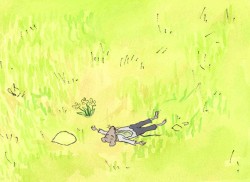 However, we had adapted Doctor DeSoto and The Amazing Bone as shorter films and could use what we’d learned from Steig on Abel. Bridget topped herself.
However, we had adapted Doctor DeSoto and The Amazing Bone as shorter films and could use what we’d learned from Steig on Abel. Bridget topped herself.
Several of the animators gave us more than I could have expected. Doug Compton‘s animation of Abel sculpting his statuary and living in his log was heart rending; Lisa Craft‘s animation of the big pocket watch, the big book and the leaf flying sequences was nothing short of inspired; and John Dilworth‘s animation of the owl fight was harrowing. This was all set up and completed by Tissa David‘s brilliant animation of Abel in the real world with wife, Amanda. She established our character.
 – At the end of the film, Abel, who has been separated from his new bride, trapped on an island for over a year, finally gets to come home. He sees Amanda in a park at twilight but decides to hold back. He races on ahead of her to greet her, privately, at home. The park sequence has a busyness as an acute counter to the lonliness we’ve watched for the previous 90% of the half-hour program. Setting it at early evening gave an opportunity for rich, royal colors. Bridget took full advantage of the opening, and underscored it all with a regal green not seen earlier. It was stunning and is one of my favorite backgrounds in the film.
– At the end of the film, Abel, who has been separated from his new bride, trapped on an island for over a year, finally gets to come home. He sees Amanda in a park at twilight but decides to hold back. He races on ahead of her to greet her, privately, at home. The park sequence has a busyness as an acute counter to the lonliness we’ve watched for the previous 90% of the half-hour program. Setting it at early evening gave an opportunity for rich, royal colors. Bridget took full advantage of the opening, and underscored it all with a regal green not seen earlier. It was stunning and is one of my favorite backgrounds in the film.
 A Child’s Garden of Verses presented new and different problems to explore.
A Child’s Garden of Verses presented new and different problems to explore.
It was a project generated by HBO. Charles Strouse and Thomas Meehan were going to write the book and song score. We met several times trying to discover a way into the book of poems. I’d suggested we use the verses in Robert Louis Stevenson‘s book to illustrate the author’s early childhood.
Stevenson was a sickly boy who was always confined to his dark room. He was not
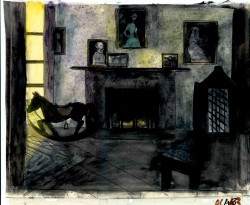 expected to live long. The only visitor for days on end was his overprotective mother.
expected to live long. The only visitor for days on end was his overprotective mother.
For much of the film, we had only the dark, child’s bedroom to explore. Artistically, I asked Bridget to delve deeper into the photgraphic dyes that she had discovered and used so well in Ira Sleeps Over. These dyes would allow us to keep the style, once again, loose while exploring dark areas and brush strokes to simulate the darkness “Robbie” lived in.
For the wallpaper throughout the house, Bridget used real wallpaper which was photostated; scaled down and reshaped to fit the backgrounds. Then watercolor washes colored these backgrounds and overlays were mixed and matched to get the desired results.
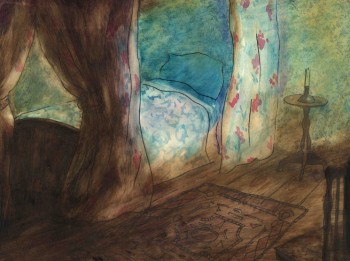 I was never quite pleased with this film. The elements that worked well worked really well. Bridget’s work was a highlight. The acting was extraordinarily good. Heidi Stallings performed with an enormous amount of emotion yet barely raised her voice above a whisper. Jonathan Pryce was brilliant as Robert Louis Stevenson, the narrator and even sang a song when asked at the last minute. Gregory Grant as the young “Robbie” was vulnerable, sweet and all we could have hoped for.
I was never quite pleased with this film. The elements that worked well worked really well. Bridget’s work was a highlight. The acting was extraordinarily good. Heidi Stallings performed with an enormous amount of emotion yet barely raised her voice above a whisper. Jonathan Pryce was brilliant as Robert Louis Stevenson, the narrator and even sang a song when asked at the last minute. Gregory Grant as the young “Robbie” was vulnerable, sweet and all we could have hoped for.
However, there was too much of a rush given the delicacy of the piece, and the exterior backrounds done by me for the end of the film are poor. The animation is also hit and miss. Oddly enough, my favorite sequence used little actual animation but intense camera work. Ray Kosarin was the animator in charge of it, and it’s an impressive sequence.
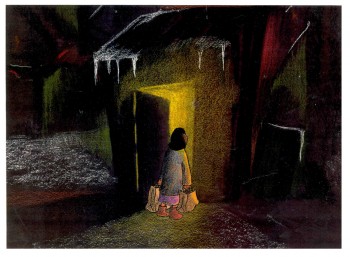
- The Talking Eggs was done for a PBS series called Long Ago & Far Away. It was an adaptation of a Creole Folk Tale which Maxine Fisher updated for me. (Lots of discussion between WGBH, Maxine & me about what distinguishes a Folk Tale from a Fairy Tale. It seriously impacted the story we were telling and I wanted what I wanted and got.)
Bridget chose to use pastels and we searched for a paper that would bring out the most grain. I loved the end result. The characters, to match the look of the Bgs, were xeroxed onto brown kraft paper and colored up from there with prismacolor pencils. This was cut out and pasted to cel.
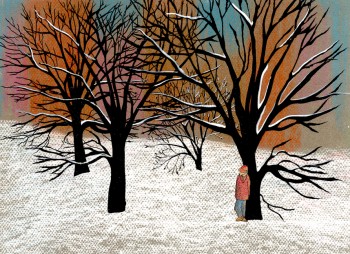 Danny Glover was the narrator, and we chose to make him an on-screen character appearing intermitently in the film. His narration was recorded on a rush as he stopped off in LA from SF on his way to direct a film in Africa.
Danny Glover was the narrator, and we chose to make him an on-screen character appearing intermitently in the film. His narration was recorded on a rush as he stopped off in LA from SF on his way to direct a film in Africa.
There’s a focus in these backgrounds that matches the content and mood of the piece, and it worked wonderfully for my purposes. I always like it when the medium is front and center; I want audiences to know that they’re watching animated drawings, and texture usually helps to do this. Of course, I also want the films to have a strong enough story that the audience gets past the point of knowing, to enter the film. It works some of the time, and I’m in heaven when it does.
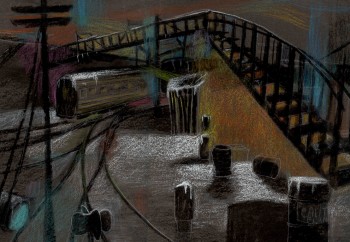 Bridget altered the color of the paper on which she was coloring with the chalks, and the different colored papers represented varied moods from sequence to sequence.
Bridget altered the color of the paper on which she was coloring with the chalks, and the different colored papers represented varied moods from sequence to sequence.
Naturally, there were some problems with the chalks under camera. All the fixative in the world didn’t stop the chalks from bleeding onto the cels or platen on the camera. (Lots more cleaning involved than usual.) We heard constantly from our cameraman, Gary Becker. The extra effort was worth it; the look was unique and successful.
Animation &Commentary &SpornFilms 10 Jan 2008 09:45 am
Tyer Breaking Joints
- Let’s talk about the breaking of joints. No, I haven’t entered Tony Sopranoland. This is an animation blog, so I’m obviously talking about the animation principle that deals with the “breaking of joints” to create any arcs or curves in animation. All human action is controlled by this method of movement. A body can only bend at joints – knees, wrists, elbows etc. Any other break is artificial and verboten in trying to make your character seem real. Any animator of the human form would swear by it.
Here’re four pages from Dick Williams’ book which illustrate the principle. Though if you look at his book – all those walks, all those bent wrists – this is one of the backbones of Dick’s training/education.
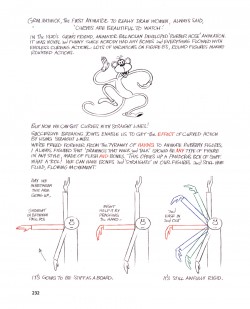 1
1  2
2
___(Click any image to enlarge.)
_
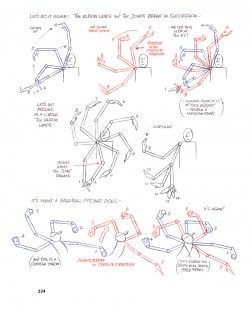 3
3 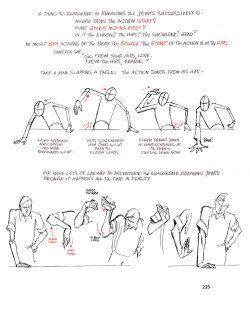 4
4
This is something I learned early on – long before I entered the business professionally.
I wasn’t sure it was spelled out in the Preston Blair book and went back to see, but it wasn’t. I don’t know where I originally read about it, but I must have somewhere – probably one of those old animation books I’d borrow from the library.
I’m sure they created it when animators at Disney in the early 30′s decided to get rid of the rubber-hose animation they’d been doing. It was a bit of rebellion. They followed the natural rules of physics. Today anything other than this would be the rebellion.
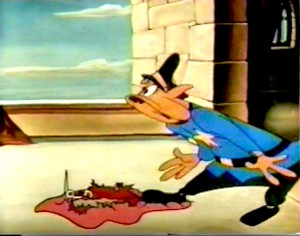 The one guy who broke this rule, and is just about idolized for it today, is Jim Tyer. His many distortions and odd working of his characters was an end in itself. This is probably what I liked about him.
The one guy who broke this rule, and is just about idolized for it today, is Jim Tyer. His many distortions and odd working of his characters was an end in itself. This is probably what I liked about him.
I’ve always seen animation as a way to caricature life not to recreate it.
Sidenote: This is why I don’t like most cgi films. They’re just trying to reproduce their form of life. Sure, Surf’s Up got those waves down pat; it’s almost perfect. Unless, of course, you’re looking for them to say something about waves rather than realistically rendering them and their movement.
Sorry, I respect it, but it’s like super-realistic painting done today; I have difficulty getting into it.
Animation is drawn. Drawing invites nonsense – even in the most serious of situations.
Tyer uses his graphic distortions to make scenes funny. In Fritz the Cat he handled some serious scenes with a quieter distortion, though it’s there just the same. It’s the acknowledgement that we’re watching an animated film that gets me charged. I like being in the moment and outside of it all at the same time.
Does that make sense?
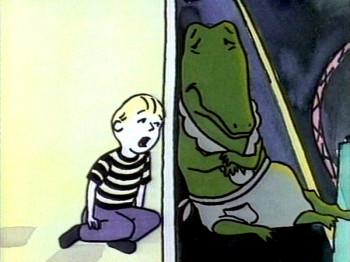 Lyle Lyle Crocodile was about a housekeeping, dancing crocodile that shares his house with a child. When his original owner comes to take Lyle away, the child gets upset, sings a song of remorse and cries. Lyle hides in a broom closet while the child sings from the other side of the door. I chose to view this as a cartoon. For god’s sake, it’s a cartoon crocodile that dances! For anyone who wants to see it, I’m mocking the situation. Visions of candy canes and ice cream cones dance around the croc’s head as he remembers the good days. I asked the composer to use a harmonica and a saxophone to pull the tears. Every time I see the scene I laugh hysterically. Most audiences don’t see this, and they weep for the boy and his pet.
Lyle Lyle Crocodile was about a housekeeping, dancing crocodile that shares his house with a child. When his original owner comes to take Lyle away, the child gets upset, sings a song of remorse and cries. Lyle hides in a broom closet while the child sings from the other side of the door. I chose to view this as a cartoon. For god’s sake, it’s a cartoon crocodile that dances! For anyone who wants to see it, I’m mocking the situation. Visions of candy canes and ice cream cones dance around the croc’s head as he remembers the good days. I asked the composer to use a harmonica and a saxophone to pull the tears. Every time I see the scene I laugh hysterically. Most audiences don’t see this, and they weep for the boy and his pet.
This is what I love. Something for me and something for people who don’t want that extra bit of separation. It’s actually a hard thing to pull off, but it’s great when you do.
The same bit is true about the breaking of joints. In every film, I go out of my way to break that rule and see if it’s noticeable. I’m not even trying to be as blatant as Jim Tyer. To be honest, I don’t think it is noticeable, although I see it every time. Tissa David hates when I do such things, but I can’t help it. I love the graphic distortions animation encourages, but I also love the rules of behaviour that help me tell staid stories. Hey, it’s great being the boss of me.
Daily post &Photos &SpornFilms 27 Dec 2007 09:03 am
Terminals, Blogs, Free Films & Krazy Kat
 - A week ago, I stepped off a train into Grand Central Station to be surprised by the kaleidoscopic carousel of lights that had been arranged in the grand terminal. I tried to take some photos, thinking it’d make a good post for this blog, but wasn’t pleased with the pictures I’d taken. It didn’t do justice to the light show.
- A week ago, I stepped off a train into Grand Central Station to be surprised by the kaleidoscopic carousel of lights that had been arranged in the grand terminal. I tried to take some photos, thinking it’d make a good post for this blog, but wasn’t pleased with the pictures I’d taken. It didn’t do justice to the light show.
Nulla has posted some fine images on her site, Blather from Brooklyn. I urge you to take a look. As a matter of fact, she’s also posted some nice pictures recorded on Christmas Day in NY. You just can’t beat this city for the show they put on. From Grand Central, to the department store windows, to the free ice skating and carousel in Bryant Park, it just gets better each year.

- My favorite Christmas Blog reading this year was the arcana Tom Sito has treated us to on his site. From wasselling to cutting trees for the home to the birth of Santa. I’ve enjoyed reading about it all, and I’ve shared it with plenty of others. Thanks, Tom..
- I’ve just found a free site set up by New Hampshire Public TV
which gives access to a number of Weston Woods films via RealPlayer. Among the many shorts available there are some eight films I’ve done for Weston adapting noted children’s books. If you’d like to see
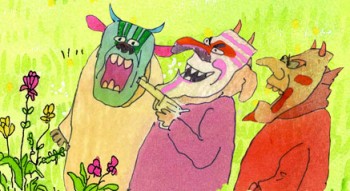 any of these films:
any of these films:
The Amazing Bone
Doctor DeSoto
Leo The Late Bloomer
The Mysterious Tadpole
Max’s Chocolate Chicken
Max’s Christmas
Morris’s Disappearing Bag
What’s Under My Bed?
They can be found here. You have to scroll down the individual categories until you come to one of these titles. They’re not hard to locate if you’re so inclined.
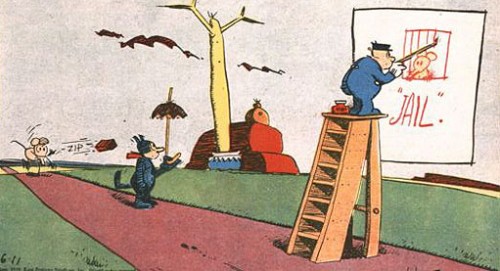
The Daily Telegraph reworks a piece by Sarah Boxer from The N Y Review of Books to give us this article on Krazy Kat. Herriman: Cartoonist who equalled Cervantes.
It honors Herriman while promoting the Fantagraphics series currently in issue.
Finally, you can tell Christmas is over when Santas start to deflate.

Thanks to Steve Fisher for this picture.
It’s almost an abstraction.
Books &Illustration &SpornFilms 08 Dec 2007 09:54 am
More Illustrated Blank Maps
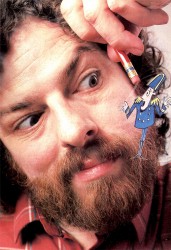 – Last week, I posted a piece about the “Map they could all understand” from Lewis Carroll’s poem, The Hunting of the Snark. It prompted a number of interesting comments. One in particular from Doug H. in Australia was followed by a delightful email full of other wonderful illustration of the same part of the poem.
– Last week, I posted a piece about the “Map they could all understand” from Lewis Carroll’s poem, The Hunting of the Snark. It prompted a number of interesting comments. One in particular from Doug H. in Australia was followed by a delightful email full of other wonderful illustration of the same part of the poem.
- “Other maps are such shapes,
______ with their islands and capes!
But we’ve got our brave Captain to thank:
(So the crew would protest)
______ “that he’s bought us the best–
A perfect and absolute blank!â€
I’d like to post some of these illustrations here, for your amusement, and with many thanks to Doug, I do so here. With respect to all of the illustrators, about half of whom
are unfamiliar names to me. They merit a good look,________me discussing the animation
especially for Snark lovers. _____________________________ process for How Magazine.
___ Just scroll down. Click any image to enlarge a bit.)
 1
1 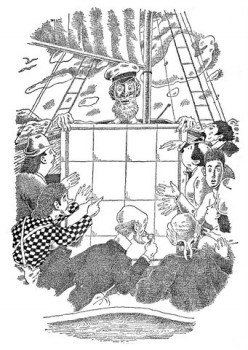 2
2
______1. Frank Hinder (1989)_______________________2. Harold Jones (1975)
______
__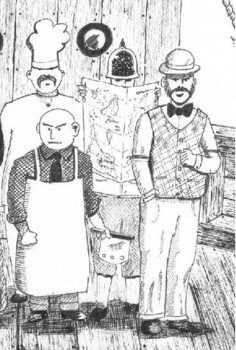 3.__
3.__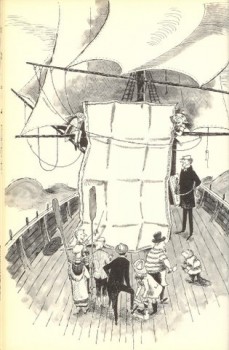 4.
4.
______3. Michael Capozzola (2005)_________________4. Kelly Oechsli (1966)
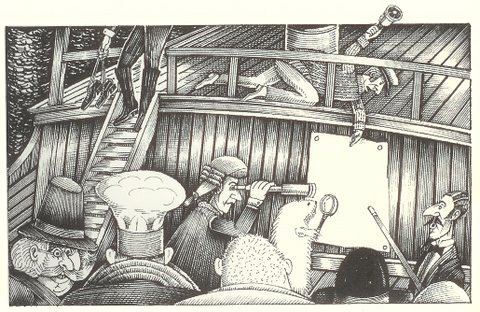 5.
5.5. John Lord (2006)
______

______
6._________________________________7.
______
______6. Max Ernst ((1950) _______________________7. Jonathan Dixon (1992)
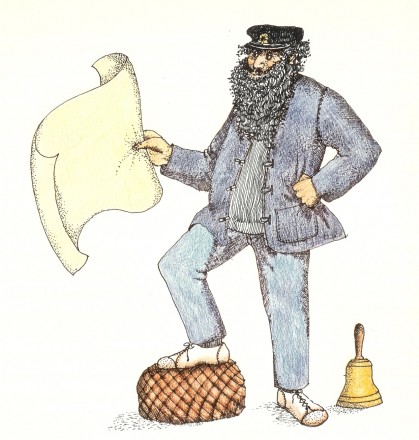 8.
8.8. Helen Oxenbury (1970)
Illustration &SpornFilms 06 Dec 2007 08:42 am
Blank Slates & Maps
 - One of my favorites of my films is The Hunting of the Snark. I adapted this from Lewis Carroll’s poem. It was an enigma to the audience when it was first published – Carroll refused to explain its meaning, and it’s an enigma now.
- One of my favorites of my films is The Hunting of the Snark. I adapted this from Lewis Carroll’s poem. It was an enigma to the audience when it was first published – Carroll refused to explain its meaning, and it’s an enigma now.
I remember screening it with an audience of fifth graders – about 200 of them along with a number of their parents. The program, in Chicago, was part of a retrospective of some of th echildren’s films I’d done at the time. I made the decision to show the Snark, even though I wasn’t sure the audience would sit still for it.
The response was amazing. The adults, during the Q&A period, had a lot of questions. The kids had no problems. When, finally, one parent asked me what it was supposed to mean, I decided to turn it around. I asked if one of the kids could answer the question. A lot of kids raised their hands, and the first one gave me the appropriate answer.
A bunch of guys go hunting for a monster________This is how the map was illustrated by
that’ll make them disappear, and one of_________the original illustrator, Henry Holiday.
them catches it. For all intent and purposes
that IS what it’s about.
I love showing this film as part of my programs. It’s easy for me to discuss, and I’m proud of it. I don’t think most animators like it, but that doesn’t bother me.
During the story there’s one key part that all illustrators love to illustrate.
But we’ve got our brave Captain to thank:
(So the crew would protest) “that he’s bought us the best–
A perfect and absolute blank!”
_
A blank page! What could be easier to illustrate? A couple of illustrators have cheated such as this map found on line:

Figure One: Bellman’s Blank Ocean Chart
Barry Smith at the University of Buffalo dept of Philosophy uses this map – a blank slate – to treat it as a map of heaven. Carroll was an Evangelical minister, but I’m confident this is not what he had in mind when he conjured up the lines in the poem.
____________________________________________
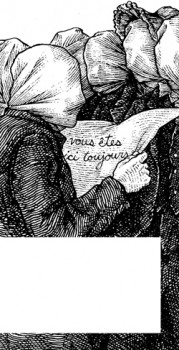 Mehendra Singh has a website which is slowly illustrating the entire poem. His illustration for this passage appears to the right. This is part of his comment accompanying the illustration.
Mehendra Singh has a website which is slowly illustrating the entire poem. His illustration for this passage appears to the right. This is part of his comment accompanying the illustration.
- Yet another shameless Magritte pastiche, and not the last one to grace these pages, I’ll wager. Shameless — the 10th Muse of Protosurrealism!
Even more shameless — this insistence that the crew of the HMS Snark use the French language for navigational purposes when it is clearly evident to anyone who has ever been lost at sea that English is the natural language of confusion. This is easily verified. Stand on a streetcorner in any francophone city and ask a stranger: where am I? If necessary, pull at shirtsleeves and wave your arms, speak very slowly while pronouncing every phoneme at the utmost decibel level.
Singh has a curious and interesting site in its own right.
Let me encourage you to check it out for all the original illustration on it.
____________________________________________
_
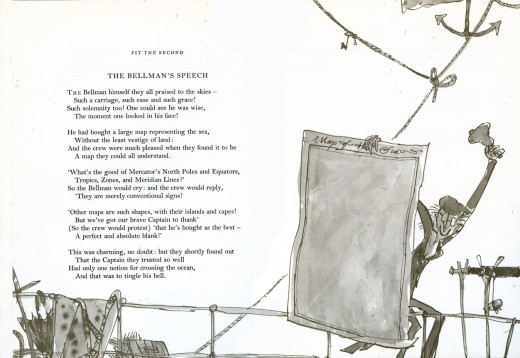
This is how Quentin Blake chose to illustrate it in his version. Since he obviously was nervous about just showing the blank map, he illustrated the Bellman holding it.
______________
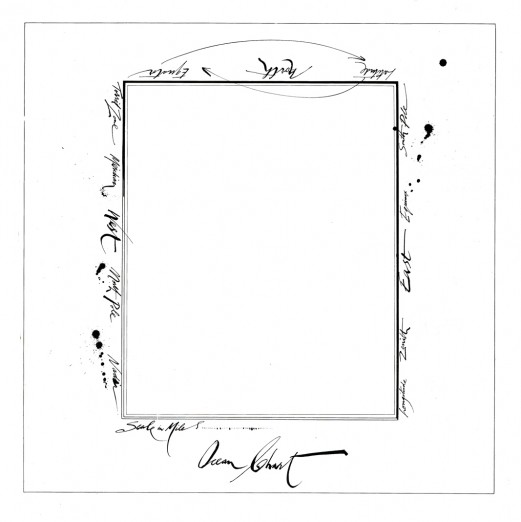
This is Ralph Steadman’s version. He went for the gold and just showed the map.
Yet, it’s still, obviously, a Steadman.
______________
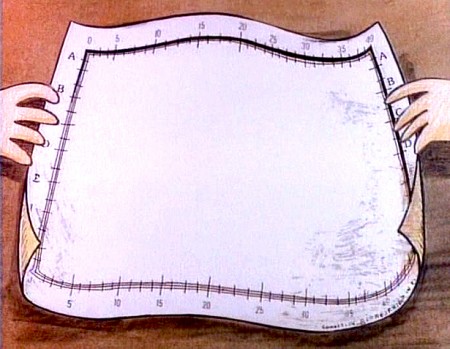
This is how I chose to depict it in my film. Showing hands and table behind it,
gave me the opportunity of trucking in to white to transition to the next scene –
an image of the sea, itself.
SpornFilms 12 Nov 2007 10:27 am
Last Day
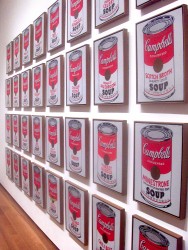 - Today is the last day of the MOMA show. I’ll be chatting with John Canemaker and Josh Siegel on stage. We haven’t really gone through it; we do have a program of clips that skip across the horizon of my studio’s history, but we haven’t really discussed the conversation. Anything goes, I guess. The problem they’ll have is stopping my talking.
- Today is the last day of the MOMA show. I’ll be chatting with John Canemaker and Josh Siegel on stage. We haven’t really gone through it; we do have a program of clips that skip across the horizon of my studio’s history, but we haven’t really discussed the conversation. Anything goes, I guess. The problem they’ll have is stopping my talking.
Among the films to be shown tonight are a lot of clips from the half hours, the titles to Garbo Talks (which hasn’t come out in dvd). I’ll talk about this piece maybe later this week. We’re going to show two versions with two different music tracks. Bob James, a great jazz pianist (he did the music for TV’s Taxi) did the original.
I have his temp track against a pencil test to screen.
He was stupidly replaced after a test screening.
Cy Coleman did the final version, a more lush and romantic track. Different. It didn’t hit the spots, just glossed over them.
We’ll also show a couple of new pieces. Pab’s First Burger was finished this past July. It’ll start the show. Gertrude On The Beach was finished a month ago. It’s a film I did with Rick Litvin to a song sung by his wife, Lucy Kaplansky‘s excellent recording. That’ll screen toward the end of the program. We’ll end with a clip from the animatic of POE. It’s a section done by Tissa that features Hugh Dancy’s voice.
- Yesterday, I went to the last two shows which were repeated from Saturday. I have to say that each program was wholly unlike the others. Just a completely different tone. The audiences for both shows on Sunday were about half full. Dave Levy and Ray Kosarin were there, and we sat together. They stayed for both shows. I was told that Saturday’s shows were packed, and I know of about a dozen or more animation people who showed up. I assume there were more since I was told they applauded whenever my name came on screen and did the same for Tissa David with The Marzipan Pig. That also happened a couple of times on Sunday. Ok, maybe I was the one who started applauding, and the rest of the audience followed.
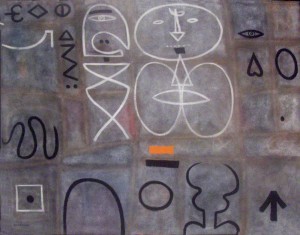 Yesterday morning, Tissa and I had a good conversation about these two programs. We went through them all and talked about what worked and what didn’t, what held up and what seemd to have dated. Of course, we also talked about the fun of making some of them.
Yesterday morning, Tissa and I had a good conversation about these two programs. We went through them all and talked about what worked and what didn’t, what held up and what seemd to have dated. Of course, we also talked about the fun of making some of them.
Tissa has never liked the backgrounds for The Marzipan Pig (though I do). She was sad when Bridget Thorne wasn’t available to do them since she loves Bridget’s work. (Bridget was having her second child during the course of that production and had bigger things to do.) Tissa would have preferred a delicate watercolor style rather than the oil pastel style I chose.
Watching that film again after all these years was every bit as enjoyable. It’s a really fine movie. Tim Curry‘s voice performance has to be one of the best I’ve heard in animation. 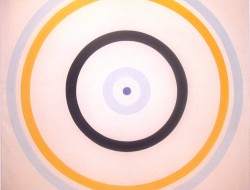 He’s such an excellent actor but gets so much trash to do in animated films. I take pleasure in knowing that his first was for me in Abel’s Island.
He’s such an excellent actor but gets so much trash to do in animated films. I take pleasure in knowing that his first was for me in Abel’s Island.
Mike and Phyllis Barrier, with Bill Benzon, arrived in time for the final program. It was great seeing them again, and we completed the day by going out for drinks afterward. Sardi’s seemed appropriate given the theater strike in progress.
Since I’m a bit tired of all this self-promotion, I’ve decided to dress up this post with paintings I photographed in the museum yesterday.
 - Yesterday, the NY Post had an interesting article about BEOWULF. Not the animation vs MoCap issue, but MoCap vs live actors. This is not animation. I repeat: this is not animation. However, there’s a nice chance that studio money could help it get the Best Animated Feature Oscar. This is definitely the time for the Academy to start writing new rules.
- Yesterday, the NY Post had an interesting article about BEOWULF. Not the animation vs MoCap issue, but MoCap vs live actors. This is not animation. I repeat: this is not animation. However, there’s a nice chance that studio money could help it get the Best Animated Feature Oscar. This is definitely the time for the Academy to start writing new rules.
Theres an article in today’s NYTimes telling us why it took a year to make the Spongebob Squarepants special which airs tonight. Maybe they’ll be able to switch to MoCap if they do one next year.
SpornFilms 11 Nov 2007 10:42 am
Party time & Thanks Part III
Yesterday, I wasn’t able to make it to any of the three screenings. They repeated the first one from Friday night and screened the next two. I was told that they went well and were filled. I’ll make up for it today by seeing the 2nd and 3rd screenings this afternoon.
Last night, we did have a party for the event, and we had a great group. Lots of schmoozing, eating and drinking. Thankfully, the drizzling rain stopped early in the day. I took a number of photos late in the party. They were rushed and I didn’t get most of the people there. I’m sorry I don’t have a picture of everyone there.
(Click any image to enlarge.)
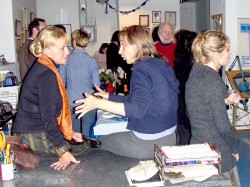 _
_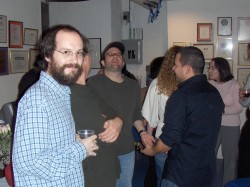
(L) Irina Margolina, Signe Bauman and Biljana Labovic
(R) Matt Clinton, Jason McDonald and Paul Carrillo
 _
_
Dave Levy and Debbie mug for the camera while Ray Kosarin looks on.
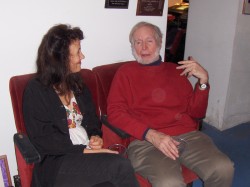 _
_
Lisa Crafts and Howard Beckerman ________ George Griffin and John Canemaker
 >_
>_
(L) Jason McDonald, Masako Kanayama, Adrian Urquidez and Janet Benn
(R) Ray Kosarin, Ken Brown, Cathy and John Celestri

All that’s left.
_____________________________________________
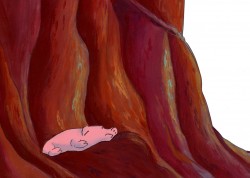 – Today is the final day of the film screenings at the Museum of Modern Art. Program II will screen at 2:45 and Program III will be screened at 4:45.
– Today is the final day of the film screenings at the Museum of Modern Art. Program II will screen at 2:45 and Program III will be screened at 4:45.
Program II:A Peaceable Kingdom includes the following films: Goodnight Moon, The Marzipan Pig, The Amazing Bone, Ira Sleeps Over, and The Story of The Dancing Frog.
This selection is somewhat dear to my heart. The Marzipan Pig and The Hunting of the Snark are my two favorites of the films. I purposefully separated them in the programs. Both are enormously different from each other, but both are similar. The metaphysical lies just on the surface as characters in animated films try to move forward with their lives. Only the important things matter to them. In the Snark they’re trying to rid the world of its demons. In the Pig they’re trying to find “love”, or, at least, connection.
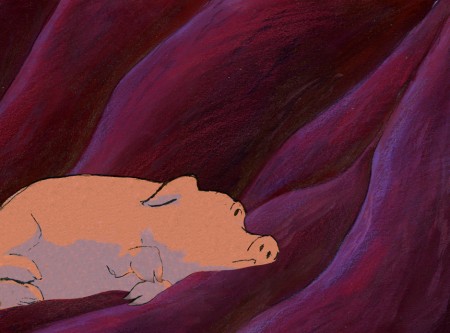
The Marzipan Pig sits while all the sweetness runs out of him.
I love all of these films, and look forward to seeing them again on a big screen. The great artists who helped put these films together include the following:
___________Julie Allen___________John Aller___________Ed Askinazi
___________Debbie Baber________Dante Barbetta______.Gary Becker
___________Quentin Blake________Bob Bushell_________Laura Bryson
___________Charlotte Cary-Booth__Doug Compton______Tim Curry
___________Billy Crystal_________.Tissa David_________John R. Dilworth
___________Rodolfo Damaggio____.Steven Dovas_______Ray Feldman
___________Wolf Ferro__________. William Finn_________Maxine Fisher
___________Danny Gerard_____-__Stephen Gambello____Eddie Gomez
___________Edna Harris_________.Xiaogang He_________Jonathan Hill
___________Russell Hoban_______.Grace Johnston______.Masako Kanayama
___________Yvette Kaplan________Carol Kilbanks_______Sophie Kittredge
___________Michael Klein________.Ray Kosarin_________James Laev
___________Stephen MacQuignon__Robert Marianetti_____Miguel Martinez
___________Mark Mayerson______.George McClements___Jason McDonald
___________Giuliana Nicodemi____.Christine O’Neill______Gregory Perler
___________Sue Perrotto_________Amanda Plummer____.Caleb Sampson
___________Susan Sarandon______Morton Schindel______Elizabeth Seidman
___________Theresa Smythe______Jarrod Specter_______Heidi Stallings
___________Michael Starobin______Jeremy Steig________William Steig
___________Tape House Toons____Ian Thomson________Bridget Thorne
___________Mary Thorne_________Bernard Waber______Mo Willems
___________Michael Wisniewski
Many thanks to all of these people for all your help in getting these films completed so beautifully.

Goodnight Moon: Duplicating a book with cg and hiding that fact.
